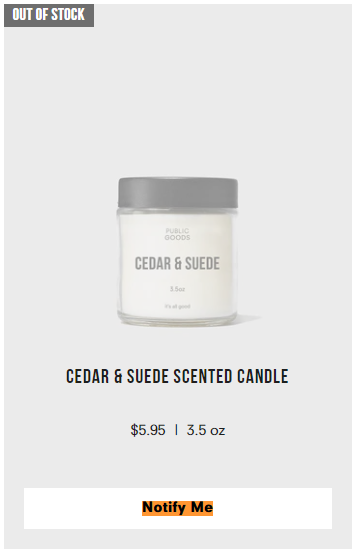Produce Zero Party Data at Scale: Guide for Ecommerce Stores
So, you understand the potential upside of implementing zero party data collection on your eCommerce store: all the personalization improvements, dialed-in product recommendations, and enhanced marketing campaigns. You’re also interested in transitioning towards ethically sourced data, to position yourself sustainably a staunch supporter of digital privacy.
Fantastic! Now there’s just one problem.
You’re used to working with other platforms’ massive data sets, and have no idea how to capture zero party data at scale within your own store’s walls.
Luckily, you aren’t alone. Countless businesses in the process of implementing zero party data collection are looking for tips and tricks to expand the scope and scale of their data sets.
In this piece, we’ll look at three examples of strategies for collecting zero party data at scale in addition to the three most common challenges eCommerce businesses face when it comes to customer data.
Three Customer Challenges eCommerce Stores Solve With Zero Party Data
Before we dive into how to scale zero party data collection, let's review three of the most pressing problems eCommerce brands are facing when it comes to customer data.
1. Reducing Customer Churn
It can be difficult to generate and capture data quickly enough to retain new customers and avoid costly churn.
First-party data, for example, requires multiple sites, apps, or page visits to begin building a customer profile that can then be analyzed for insights. Third-party data can be unreliable, irrelevant, and even drive customers away if it isn’t ethically sourced.
2. Attribution
Without rock-solid attribution, it can be impossible to strategically identify, optimize, and scale your brand’s most effective marketing strategies.
Getting a clear view of your attribution trends can position brands to capitalize on ad spending and drive massive amounts of revenue by investing in their most profitable marketing strategies and channels.
3. Digital Privacy
Digital privacy has become increasingly important to consumers, with a full 84% of consumers indicating that they care about the privacy of their own data, the privacy of society’s data at large, and the amount of control they have over their data.
This uptick in concerns has led to growing digital privacy regulations and shifting public opinion that could land brands in hot water if their data collection isn’t up to par.
How to Produce Zero Party Data at Scale: Examples and Use Cases
Now, let’s take a look at three large-scale zero party data capturing strategies that you can implement in your brand or business today.
1. Quizzes For Personalized Shopping Suggestions
Style quizzes, personality tests, and product-based quizzes can be excellent tools for large-scale zero party data collection.
Example: L’oreal’s Skincare Routine Finder Quiz
L’oreal came up with a creative and unique way to gather personalization-heavy zero party data from online shoppers.
By creating a quiz that allowed customers to find the best products for their skin type, L’oreal improved customers’ experiences, created a valuable buzz on social media, and most importantly captured extremely detailed and valuable data that was then leveraged into fine-tuned product recommendations.
How to Do The Same For Your Store
To get started, you’ll need a creative, engaging quiz that provides genuine value to your target demographic. If your quiz isn’t relevant and doesn’t include a clear value exchange (in L’oreal’s case, improved personalization and product recommendations) then you may struggle to build the steam you need to reach scale.
2. Email Opt-In for Back-in-Stock Items
Having a killer product you can’t keep in stock is a perfect recipe for large-scale zero party data collecting.
Example: Email Opt-in in Public Goods' Shopify Store
Believe it or not, running out of your best-selling product isn’t a bad thing. In fact, brands can capitalize on this scenario and capture valuable zero party data.
How? With a “back in stock!” email opt-in!

Customers that still want to get their hands on your top seller will jump at the chance to get an early drop alert before your next restock. This strategy exemplifies the importance of value exchange - if the product weren’t so highly desired, customers might not feel compelled to share their contact information.
How to Do The Same For Your Store
Setting up this form of large-scale zero party data collection is surprisingly easy. Simply set up an email opt-in form that allows customers to trade their contact information for early alerts and product updates and wait for the ethically-sourced, happily-provided zero party data to start rolling in.
3. Post-Purchase Surveys Using Fairing
Post-purchase surveys (like the ones offered by Fairing) are another fantastic way to easily capture massive sets of zero party data.

Post-purchase surveys empower brands to capture essential data like attribution, product preferences, and buying experiences. Post-purchase surveys can also be easily modified to capture almost any kind of data you want (assuming you can come up with a creative enough survey!).
Example: Post-Purchase Survey in Füm's Shopify Store
Fairing partner Füm used post-purchase surveys to discover between 40 and 50% of their online visitors were discovering their brand through their podcast and YouTube channel. This insight allowed Füm to optimize and scale their ad spend from $5,000 to $125,000, driving $500,000 in revenue during the process.
How to Do The Same For Your Store
Implementing a post-purchase survey is the easiest way to begin collecting large-scale zero party data that can be operationalized in no time. That’s because zero party collection specialists like Fairing have built intuitive Shopify plug-ins that allow brands to begin capturing zero party data entirely for free .
Produce Zero Party Data For Your Shopify Store With Fairing
Learning how to capture zero party data at scale will be essential for brands and businesses that want to stay competitive after the death of the third-party cookie.
Fortunately, eCommerce shops have a variety of zero party tools, techniques, and strategies at their disposal to guide them through this upheaval to the status quo. Post-purchase surveys, email opt-ins, and personalization quizzes.
If you’d like to see the power of zero party data collection first-hand without a commitment, check out Fairing’s post-purchase survey free trial here.
Want to learn how to set up your post-purchase survey for your brand? Read more here.





